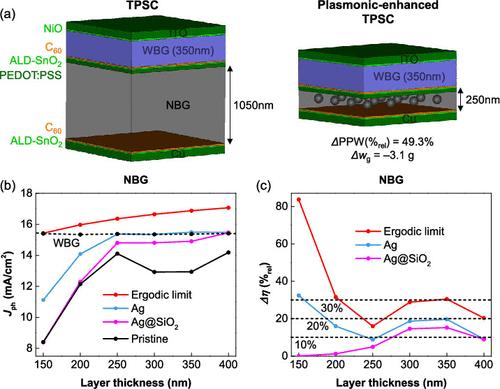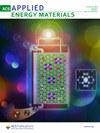等离子纳米粒子对透闪石-透闪石串联太阳能电池厚度和重量的影响
IF 5.4
3区 材料科学
Q2 CHEMISTRY, PHYSICAL
引用次数: 0
摘要
在这项工作中,我们报告了分散在过氧化物-过氧化物串联太阳能电池(TPSCs)的混合(铅锡)窄带隙(NBG)过氧化物层内的不同成分、尺寸、垂直位置、浓度和外壳厚度的金属纳米粒子对 TPSCs 的(i)NBG 厚度降低、(ii)吸收和(iii)单位重量功率输出(PPW)增强的等离子体影响。目的是为开发高效、可行和环保的等离子体增强串联太阳能电池制定指导方针,并通过对 TPSC 架构进行详细的数值分析和优化程序,研究金属纳米粒子的等离子体和重量对太阳能电池和串联配置的 PPW 输出的影响。在当前匹配条件下,前宽带隙子电池的 NBG 厚度预计会大幅减少(650 nm,减少 60%),而 PPW 则会增加(+14 W/g,提高 50%)。结果表明,增强的光捕获(由于局部表面等离子体效应)与加工过程中的金属纳米粒子简约性相结合,为使用比通常使用的 NBG 薄膜更薄(1 μm)的 NBG 薄膜实现高效、可行的 TPSC 提供了一种方法;1 μm),从而促进光载体的收集,降低成本和器件中可能有毒的铅锡含量,并提高 PPW 的输出。详细的理论分析为各种可受益于等离子体效应和带隙可调性的应用提供了指导,这些应用包括不同材料的光伏(如过氧化物有机串联)、PPW 应用、发光二极管和传感器,还进一步促进了 TPSC 在新兴应用中的可行性,如空间应用、便携式/可穿戴电子产品、汽车或对光伏面板的 PPW 比率有严格限制的其他应用。本文章由计算机程序翻译,如有差异,请以英文原文为准。

Plasmonic Nanoparticles’ Impact on Perovskite–Perovskite Tandem Solar Cells’ Thickness and Weight
In this work, we report on the plasmonic impact of metal nanoparticles of different compositions, sizes, vertical positions, concentrations, and shell thicknesses dispersed inside the mixed (lead–tin) narrow-band gap (NBG) perovskite layer of perovskite–perovskite tandem solar cells (TPSCs) on TPSCs’ (i) NBG thickness reduction, (ii) absorption, and (iii) power-per-weight output (PPW) enhancement. The aim is to establish guidelines for the highly promising development of efficient, viable, and environmentally friendly plasmonic-enhanced tandem solar cells and examine metal nanoparticles’ plasmonic and weight impact on the PPW output of solar cells and tandem configurations by means of a detailed numerical analysis and optimization procedure on TPSC architectures. Based on the high NBG thickness reductions predicted (>650 nm, >60% decrease) and PPW increase (+14 W/g, ∼50% improvement) under current matching conditions with the front wide-band gap subcell, results indicate that enhanced light-trapping (due to localized surface-plasmon effects) combined with metal nanoparticles simplicity at processing provide a means to attain efficient and viable TPSCs using NBG films much thinner than those usually employed (>1 μm), thus facilitating collection of photocarriers, reducing cost and the amount of potentially toxic lead–tin present in the device, and enhancing PPW output. The detailed theoretical analysis serves as a guide for various applications that can benefit from the plasmonic effect and band gap tunability, including photovoltaics of different materials (e.g., perovskite-organic tandems), PPW applications, light-emitting diodes, and sensors, also further promoting the viability of TPSCs in emerging applications such as space applications, portable/wearable electronics, automobiles, or other applications where there is a stringent limitation on the PPW ratio of the photovoltaic panel.
求助全文
通过发布文献求助,成功后即可免费获取论文全文。
去求助
来源期刊

ACS Applied Energy Materials
Materials Science-Materials Chemistry
CiteScore
10.30
自引率
6.20%
发文量
1368
期刊介绍:
ACS Applied Energy Materials is an interdisciplinary journal publishing original research covering all aspects of materials, engineering, chemistry, physics and biology relevant to energy conversion and storage. The journal is devoted to reports of new and original experimental and theoretical research of an applied nature that integrate knowledge in the areas of materials, engineering, physics, bioscience, and chemistry into important energy applications.
 求助内容:
求助内容: 应助结果提醒方式:
应助结果提醒方式:


